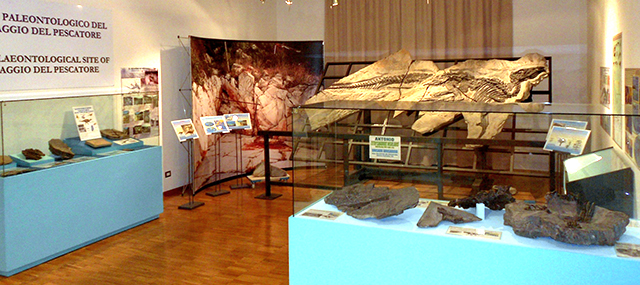map pin / antonio’s technical file
the dinosaurs of the villaggio del pescatore, trieste
Tethyshadros insularis is the biggest dinosaur ever discovered in Italy and one of the most complete in the world. Since the time when it was discovered, in 1994, it has been known with the nickname “Antonio”. Its skeleton is exceptionally maintained and jointed in anatomical connection. It presents a mixture of primitive and evolved characteristics, distinguishing it from all others Hadrosauroids known: its forelimbs have only three fingers; its hindlimbs are long and strong; the end part of its tail is thin and whip-like; its head is big and extended. These exclusive features, associated with the reduced dimensions (about 4 meters long and 1.3 meters high), suggested the theory that the Tethyshadros probably lived in an insular habitat (the animals that live in the islands often developed rare features due to the isolation) with a tropical or sub-tropical climate. Antonio was a vegetarian dinosaur, indeed it tore plants with the anterior part of its muzzle and after that it crushed them with itsdental battery, in which there were tens of small teeth, replace repeatedly. In spite of its name, the sex of the specimen is not yet determined.
Deborah Arbulla
Civico Museo di Storia Naturale, Trieste

courtesy Civico Museo di Storia Naturale–Trieste
Scientific Name: Tethyshadros insularis Dalla Vecchia, 2009.
Scientific classification: primitive Hadrosauroid.
Length: 4 meters (13 Ft).
Height: 1.30 m (4.26 Ft).
Weight: about 700 Kg (1543.21 Lb).
Sex: unspecified.
Diet: vegetables.
Life habits: since it is a new genus and a rare specimen it is hard to tell something about its life habits.
Habitat: Tethyshadros lived on a quite small island, which has nearly the same dimensions of the island of Cuba in nowadays. This island has recently emerged from the sea and it is located in the west side of the Tethys Ocean, between Africa and the continental land of Northern Europe. The habitat where Tethyshadros lived was a tropical coastal plain, where there were found tropical plant pollens. That plain was close to a body of brackish water that present a muddy unoxygenated bottom, in which the dinosaur fell and kept buried. The particular sedimentations (laminites) prove this theory.
Climate: tropical or sub-tropical; however warmer than the actual climate.
Coeval animals of the site: until today there were been found crocodiles (Acynodon adriaticus), characterized by the short muzzle and the long paws, in addition to a metacarpal bone of a flying reptile and also several bad-maintained skeletons of small fishes and shrimps. Moreover, in the same site, there were discovered rests of Hadrosauroids of a greater size.
Observations:
• This is the first Italian dinosaur discovered on-site, systematically excavated and prepared.
• The Italian fossil is the biggest one attributed to a dinosaur.
• It is the most complete dinosaur of average/big size ever discovered in Europe since the discovering of the Iguanodon and the Dollodon in Bernissart (Belgium, 1878). It is also one of the most complete dinosaurs ever discovered in the world.
• The Tethyshadros is the first whole skeleton of Hadrosaurid, having an intermedium form between the primitive Iguanodont and theevolved Hadrosaurids of Northern America.
English translation Giulia Mauro